|
|
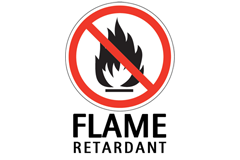 Kabelmaterialet är tillverkat av flamskyddsmedel och är därför lämpligt för nätverksinstallationer i offentliga och kommersiella byggnader, skolor, institutioner osv., eftersom det ställs höga krav på kablageinstallationer att vara flamskyddade eller deras reaktion vid brand enligt senaste brandskyddsföreskrifterna, som beskrivs i byggproduktförordningen EN 50575 "Kraft-, signal- och kommunikationskablar. Kablar för allmän användning i byggnadsverk med krav på brandreaktion".
Kabelmaterialet är tillverkat av flamskyddsmedel och är därför lämpligt för nätverksinstallationer i offentliga och kommersiella byggnader, skolor, institutioner osv., eftersom det ställs höga krav på kablageinstallationer att vara flamskyddade eller deras reaktion vid brand enligt senaste brandskyddsföreskrifterna, som beskrivs i byggproduktförordningen EN 50575 "Kraft-, signal- och kommunikationskablar. Kablar för allmän användning i byggnadsverk med krav på brandreaktion".
Kablarna måste även uppfylla kraven för en ny europeisk brandklassificering, som fastställs utifrån tester av energiinnehåll, syrabildning, värmefrigörelse, rökproduktion, droppbildning och brandspridning. De befintliga brandklasserna kommer att ersättas med sju nya kategorier från A till F, som detaljerat beskrivs i standarden.
Typiskt kan endast ett undantag ges för 10% av kablarna som inte är flamskyddade i kommersiella byggnader. Men för att underlätta arbetet är det därför enklast att "bara" välja kablar med rätt godkännanden, inom både ström-, nätverks-, högtalar- och datakablar för alla fasta installationer, när det byggs nytt eller moderniseras.
EN 50575-standarden som bok är inte gratis, men kan köpas online från myndigheterna. |
| |
| |
VISA PRODUKTER |
|
|
|
|
|
 Dante is an audio networking technology developed by Audionate. Dante devices on the same network automatically detect each other. This can make setting up a system simpler and thus reduce complexity and potential errors. In this sense, Dante can be thought of as a plug-and-play network technology.
Dante is an audio networking technology developed by Audionate. Dante devices on the same network automatically detect each other. This can make setting up a system simpler and thus reduce complexity and potential errors. In this sense, Dante can be thought of as a plug-and-play network technology. |
| |
| Läs mer om Dante® link |
VISA PRODUKTER |
|
|
|
|
|
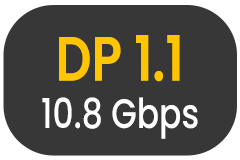 De inledande versionerna av DisplayPort, 1.0 till 1.1a, godkändes mellan maj 2006 och januari 2008. De levererade en maximal bandbredd på 10,8 Gbit/s över en 4-lans huvudlänk, med kablar upp till 2 meter i längd som krävdes för full bandbreddsstöd.
De inledande versionerna av DisplayPort, 1.0 till 1.1a, godkändes mellan maj 2006 och januari 2008. De levererade en maximal bandbredd på 10,8 Gbit/s över en 4-lans huvudlänk, med kablar upp till 2 meter i längd som krävdes för full bandbreddsstöd.
DP-version 1.1 tillät alternativa länklager, som fiberoptik, vilket möjliggjorde längre räckvidd utan signalnedbrytning. Dessutom ingick HDCP och DisplayPort Content Protection. |
| |
| Läs mer om Displayport 1.1 – High Speed (HBR1 upp till 10,8 Gbit/s) |
VISA PRODUKTER |
|
|
|
|
|
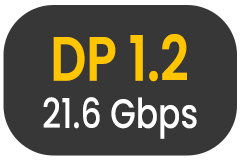 DisplayPort (DP) version 1.2, lanserad 2010, introducerade flera förbättringar för standarden för bildskärmsanslutningar. Uppdateringen ökade den maximala datahastigheten, möjliggjorde högre upplösningar och uppdateringsfrekvenser samt stödde flera skärmar genom MST. Den inkluderade också stöd för 3D och förbättrad synkronisering mellan ljud och video. DisplayPort-version 1.2a, släppt 2013, inkluderade Adaptive Sync, från vilken AMD's avancerade FreeSync härstammade. Adaptive Sync integrerades senare som en valfri funktion i DisplayPort-standarden.
DisplayPort (DP) version 1.2, lanserad 2010, introducerade flera förbättringar för standarden för bildskärmsanslutningar. Uppdateringen ökade den maximala datahastigheten, möjliggjorde högre upplösningar och uppdateringsfrekvenser samt stödde flera skärmar genom MST. Den inkluderade också stöd för 3D och förbättrad synkronisering mellan ljud och video. DisplayPort-version 1.2a, släppt 2013, inkluderade Adaptive Sync, från vilken AMD's avancerade FreeSync härstammade. Adaptive Sync integrerades senare som en valfri funktion i DisplayPort-standarden. |
| |
| Läs mer om Displayport 1.2 – High Speed (HBR2 upp till 21,6 Gbit/s) |
VISA PRODUKTER |
|
|
|
|
|
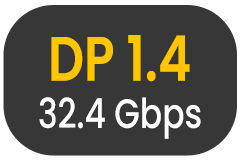 DisplayPort-version 1.3, godkänd i september 2014, ökar transmissionsbandbredden till 32,4 Gbit/s med den nya HBR3-läget, vilket möjliggör högre upplösningar och snabbare uppdateringshastigheter. Detta stöder 4K UHD vid 120 Hz, 5K vid 60 Hz eller 8K vid 30 Hz.
DisplayPort-version 1.3, godkänd i september 2014, ökar transmissionsbandbredden till 32,4 Gbit/s med den nya HBR3-läget, vilket möjliggör högre upplösningar och snabbare uppdateringshastigheter. Detta stöder 4K UHD vid 120 Hz, 5K vid 60 Hz eller 8K vid 30 Hz.
Standarden stödjer också att köra flera skärmar och inkluderar Dual-mode för DVI- och HDMI-adaptrar. Thunderbolt 3 var ursprungligen tänkt att inkludera DisplayPort 1.3, men slutade med version 1.2. Adaptive Sync förblir valfritt. DisplayPort-version 1.4, släppt i mars 2016, bibehåller HBR3 som det högsta läget och introducerar stöd för funktioner som Display Stream Compression, HDR10-metadata och utökade ljudkanaler. |
| |
| Läs mer om Displayport 1.4 – High Speed (HBR3 upp till 32,4 Gbit/s) |
VISA PRODUKTER |
|
|
|
|
|
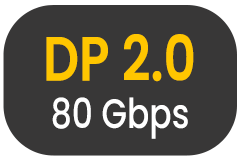 DisplayPort 2.0 släpptes officiellt av VESA i juni 2019. Denna version markerar den första stora uppdateringen sedan mars 2016 och ökar datahastigheten med cirka 3 gånger (från 25,92 till 77,37 Gbit/s) jämfört med den tidigare versionen (1.4a).
DisplayPort 2.0 släpptes officiellt av VESA i juni 2019. Denna version markerar den första stora uppdateringen sedan mars 2016 och ökar datahastigheten med cirka 3 gånger (från 25,92 till 77,37 Gbit/s) jämfört med den tidigare versionen (1.4a).
DisplayPort 2.0 introducerar nya möjligheter för att möta framtida krav på prestanda för traditionella skärmar, inklusive stöd för upplösningar över 8K, högre uppdateringsfrekvenser och HDR-stöd vid högre upplösningar.
Konfigurationsalternativen inkluderar enskild skärmupplösning upp till 16K vid 60 Hz med 10 bpc RGB/Y'CBCR 4:4:4 färg, eller dubbel skärmupplösning med två 8K-skärmar vid 120 Hz. Med DisplayPort 2.0:s ökade bandbredd erbjuder VESA en hög grad av flexibilitet och konfigurationsmöjligheter för högre upplösningar och uppdateringsfrekvenser. |
| |
| Läs mer om Displayport 2.0 – High Speed (UHBR upp till 80 Gbit/s) |
VISA PRODUKTER |
|
|
|
|
|
 VESA tillkännagav version 2.1 av DisplayPort-standarden i oktober 2022. Denna uppdatering introducerar DP40- och DP80-kabelcertifieringar för att säkerställa korrekt drift vid hastigheterna UHBR10 (40 Gbit/s), UHBR13,5 (54 Gbit/s) och UHBR20 (80 Gbit/s), som introducerades i version 2.0.
VESA tillkännagav version 2.1 av DisplayPort-standarden i oktober 2022. Denna uppdatering introducerar DP40- och DP80-kabelcertifieringar för att säkerställa korrekt drift vid hastigheterna UHBR10 (40 Gbit/s), UHBR13,5 (54 Gbit/s) och UHBR20 (80 Gbit/s), som introducerades i version 2.0.
Den reviderar också vissa av de elektriska kraven för DisplayPort-enheter för att bättre integreras med USB4. DisplayPort 2.1 samordnar närmare med USB Type-C- och USB4 PHY-specifikationerna, vilket möjliggör en gemensam PHY för både DisplayPort och USB4. Dessutom lägger den till en ny funktion för bandbreddshantering för DisplayPort för att underlätta mer effektiv samexistens med annan I/O-datatrafik över USB4. |
| |
| Läs mer om Displayport 2.1 – High Speed (UHBR upp till 80 Gbit/s, USB4) |
VISA PRODUKTER |
|
|
|
|
|
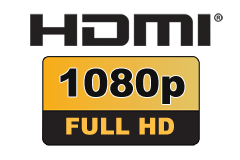 HDMI 1.4 supports a resolution up to 3840x2160 at 30 Hz and 1920x1080 at 120 Hz. At the same time, there is support for ARC, 3D, CEC management and more.
HDMI 1.4 supports a resolution up to 3840x2160 at 30 Hz and 1920x1080 at 120 Hz. At the same time, there is support for ARC, 3D, CEC management and more.
Note that HDMI 1.4 does not have the capability to support HDR. |
| |
| |
VISA PRODUKTER |
|
|
|
|
|
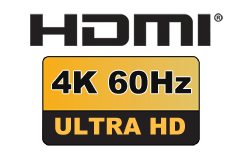 The product is ready and compatible with the newest version of Ultra HD with 4K 60 Hz support including HDCP 2.2, which is a technology for preventing illegal copying of 4K UHD content. Every piece of equipment in a setup must support HDCP 2.2 for a signal with this coding to pass through.
The product is ready and compatible with the newest version of Ultra HD with 4K 60 Hz support including HDCP 2.2, which is a technology for preventing illegal copying of 4K UHD content. Every piece of equipment in a setup must support HDCP 2.2 for a signal with this coding to pass through. |
| |
| |
VISA PRODUKTER |
|
|
|
|
|
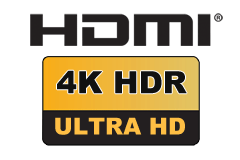 The product supports 4K resolution and HDR (High Dynamic Range), which has a greater separation of color nuances, giving a wider pallette to colorize the image, and this resulting on more vibrant and lifelike colors.
The product supports 4K resolution and HDR (High Dynamic Range), which has a greater separation of color nuances, giving a wider pallette to colorize the image, and this resulting on more vibrant and lifelike colors. |
| |
| |
VISA PRODUKTER |
|
|
|
|
|
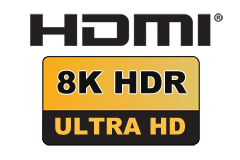 There is support for resolutions up to 7680x4320 as well as HDR.
There is support for resolutions up to 7680x4320 as well as HDR. |
| |
| |
VISA PRODUKTER |
|
|
|
|
|
 USB Power Delivery 2.0 introduced some changes to the way that power ratings between devices are handled, making the standard more flexible than before. The old set of Power Profiles were removed in PD 2.0 and replaced by Power Rules that allow for a wider range of current negotiations. The USB 3.1 specification adopted Power Profiles instead, but is only rated up to 15W rather than 100W.
USB Power Delivery 2.0 introduced some changes to the way that power ratings between devices are handled, making the standard more flexible than before. The old set of Power Profiles were removed in PD 2.0 and replaced by Power Rules that allow for a wider range of current negotiations. The USB 3.1 specification adopted Power Profiles instead, but is only rated up to 15W rather than 100W.
PD 3.0 made some tweaks to enhance power delivery, but the Power Rules are the same as PD 2.0 products. Rules are split into four target power categories; 7.5W, >15W, >27W, and >45W; each of which offers a range of voltage and current configurations. Sources supplying more than 15 watts offer voltages of 5 and 9 volts, those supplying more than 27 watts offer 5, 9 and 15 volts, and those supplying more than 45 watts offer 5, 9, 15 and 20 volts. The maximum 100W power supply is achieved with 20V and up to 5A, although all of the other modes cap out at 3A, depending on the required power.
• Increased power levels from existing USB standards up to 100W.
• The power direction is no longer fixed. This enables the product with the power (Host or Peripheral) to provide the power.
• Optimize power management across multiple peripherals by allowing each device to take only the power it requires, and to get more power when required for a given application.
• Intelligent and flexible system-level management of power via optional hub communication with the PC.
• It allows low power cases such as headsets to negotiate for only the power they require. |
| |
| Läs mer om Laddning: Power Delivery |
VISA PRODUKTER |
|
|
|
|
|
 Qi (pronounced/ CHEE from the Chinese word qi) is an open interface standard that defines wireless power transfer using inductive charging over distances of up to 4 cm (1.6 inches), developed by the Wireless Power Consortium. The system uses a charging pad and a compatible device, which is placed on top of the pad, charging via resonant inductive coupling.
Qi (pronounced/ CHEE from the Chinese word qi) is an open interface standard that defines wireless power transfer using inductive charging over distances of up to 4 cm (1.6 inches), developed by the Wireless Power Consortium. The system uses a charging pad and a compatible device, which is placed on top of the pad, charging via resonant inductive coupling.
Version 1.0 - 2010 up to 5 Watt
Version 1.1 - 2012 up to 5 Watt
Version 1.2 - 2015 up to 15 Watt |
| |
| Läs mer om Laddning: Qi trådlös laddningsstandard |
VISA PRODUKTER |
|
|
|
|
|
 If you’re new to the concept of quick charging, the result is in the name: your smartphone charges up faster than it would without Quick Charge technology.
If you’re new to the concept of quick charging, the result is in the name: your smartphone charges up faster than it would without Quick Charge technology.
Qualcomm boasts a fourfold increase in charging times over conventional chargers with Quick Charge 3.0, up from the 40 percent speed increase offered by its first-generation technology. However, one of the interesting things to note is that Qualcomm isn’t touting massive increases in charging times over version 2.0, instead, the company is focusing on improved efficiency this time around.
Voltage
• 3.6 V to 22 V, dynamic with 200 mV increments
Max current
• 2.6 A or 4.6 A
Max power
• 36 W (12 V x 3 A)
The major new feature with 3.0 is INOV (Intelligent Negotiation for Optimum Voltage), which allows for a fined tuned power output and a more optimized charging cycle. Firstly, different batteries require different charging voltages. Version 2.0 supported four modes at varying power levels, 5 volts/2amps, 9V/2A, 12V/1.67A, and a 20 volt option. Quick Charge 3.0’s INOV communicates with the device to request any voltage between 3.2V and 20V at 200mV increments, allowing for a wider selection of voltages.
Importantly, Qualcomm has retained backward compatibility with its 2.0 and 1.0 standards. As the power draw is handled on the smartphone side, you will safely receive the maximum amount of power for your device using any of the certified chargers. However, you won’t achieve full charging speeds if you try charging newer phones with older lower power chargers.
Although Qualcomm supports Quick Charge in all of its new SoCs, it is still up to smartphone and tablet manufacturers to implement the specific circuitry required to make full use of the fastest charging speeds available. |
| |
| Läs mer om Laddning: Quick Charge |
VISA PRODUKTER |
|
|
|
|
|
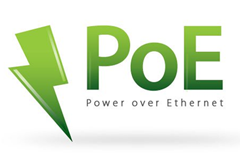 Power over Ethernet (PoE, EEE 802.3af-2003) is a cleber standard to supply ethernet connected devices, with power up to 15,4 Watt per PoE network switch port. The supply voltage are transmitted within the same ethernet cables as the data stream, and thereby only one CAT cable is needed, for e.g. IP cameras, Wi-Fi access points, door stations etc. The PoE standarden has been further developed into the PoE Plus/+ version (IEEE 802.3at-2009), which can delivery up to 25,5 Watt pr. connection, and are often utilized for HD network IP cameras.
Power over Ethernet (PoE, EEE 802.3af-2003) is a cleber standard to supply ethernet connected devices, with power up to 15,4 Watt per PoE network switch port. The supply voltage are transmitted within the same ethernet cables as the data stream, and thereby only one CAT cable is needed, for e.g. IP cameras, Wi-Fi access points, door stations etc. The PoE standarden has been further developed into the PoE Plus/+ version (IEEE 802.3at-2009), which can delivery up to 25,5 Watt pr. connection, and are often utilized for HD network IP cameras.
We recommends minimum Category 6 or 6A ethernet cables for a stable connection of PoE network equipment. |
| |
| Läs mer om PoE – Power over Ethernet |
VISA PRODUKTER |
|
|
|
|
|
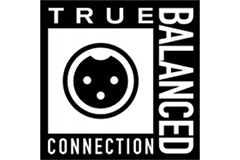 Balanserade ljudanslutningar är typiskt kända från professionella områden som inspelningsstudior eller livekonserter. Det är mycket viktigt att ha en stabil och störningsfri anslutning, eftersom dessa signaler kommer att förstärkas kraftigt. Detsamma gäller anslutningen från din skivspelare till din RIAA-förstärkare. Den stora fördelen med en balanserad anslutning är dess förmåga att eliminera brus och störningar som den fångar upp. Och det bästa av allt är att pickuper av naturen redan är balanserade signalomvandlare! Med True Balanced använder du helt enkelt allt, bokstavligen allt, som din pickup fångar upp från skivans spår - För att säkerställa den bästa anslutningen till din RIAA-förstärkare har Pro-Ject designat deras 'True Balanced Connection'.
Balanserade ljudanslutningar är typiskt kända från professionella områden som inspelningsstudior eller livekonserter. Det är mycket viktigt att ha en stabil och störningsfri anslutning, eftersom dessa signaler kommer att förstärkas kraftigt. Detsamma gäller anslutningen från din skivspelare till din RIAA-förstärkare. Den stora fördelen med en balanserad anslutning är dess förmåga att eliminera brus och störningar som den fångar upp. Och det bästa av allt är att pickuper av naturen redan är balanserade signalomvandlare! Med True Balanced använder du helt enkelt allt, bokstavligen allt, som din pickup fångar upp från skivans spår - För att säkerställa den bästa anslutningen till din RIAA-förstärkare har Pro-Ject designat deras 'True Balanced Connection'. |
| |
| |
VISA PRODUKTER |
|
|
|
|
|
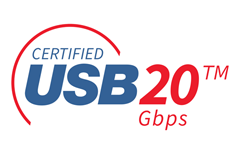 USB4 baseras på Thunderbolt 3-protokollspecifikationen. Den stöder 20 Gbit / s genomgångar, är kompatibel med Thunderbolt 3 och bakåtkompatibel med USB 3.2 och USB 2.0.
USB4 baseras på Thunderbolt 3-protokollspecifikationen. Den stöder 20 Gbit / s genomgångar, är kompatibel med Thunderbolt 3 och bakåtkompatibel med USB 3.2 och USB 2.0.
Arkitekturen definierar en metod för att dela en enda höghastighetslänk med flera typer av enhetstyper dynamiskt som bäst tjänar överföringen av data efter typ och applikation. |
| |
| Läs mer om USB4 Gen. 2 (20 Gbit/s) |
VISA PRODUKTER |
|
|
|
|
|
 USB4 baseras på Thunderbolt 3-protokollspecifikationen. Den stöder 40 Gbit / s genomgångar, är kompatibel med Thunderbolt 3 och bakåtkompatibel med USB 3.2 och USB 2.0.
USB4 baseras på Thunderbolt 3-protokollspecifikationen. Den stöder 40 Gbit / s genomgångar, är kompatibel med Thunderbolt 3 och bakåtkompatibel med USB 3.2 och USB 2.0.
Arkitekturen definierar en metod för att dela en enda höghastighetslänk med flera typer av enhetstyper dynamiskt som bäst tjänar överföringen av data efter typ och applikation. |
| |
| Läs mer om USB4 Gen. 3 (40 Gbit/s) |
VISA PRODUKTER |
|
|
|
|
|
 The Wireless Speaker & Audio (WiSA) Association is an industry group dedicated to implement wireless technology into stereo- and surround sound speakers, control boxes and televisions. The vision is to rid the installation of speaker wires and clunky AV receivers, while achieving quality audio and stable, synchronized connection.
The Wireless Speaker & Audio (WiSA) Association is an industry group dedicated to implement wireless technology into stereo- and surround sound speakers, control boxes and televisions. The vision is to rid the installation of speaker wires and clunky AV receivers, while achieving quality audio and stable, synchronized connection.
WiSA can be freely adopted by any manufacturer who wishes to do so. Among the first movers are Klipsch and B&O. Now also TV manufacturers are also beginning to implement WiSA wireless sound directly in flatscreens, making it easy to connect active wireless Hi-Fi WiSA speakers to the TV without cables. |
| |
| Läs mer om WiSA - Wireless Speaker & Audio |
VISA PRODUKTER |
|
|
|
|
|